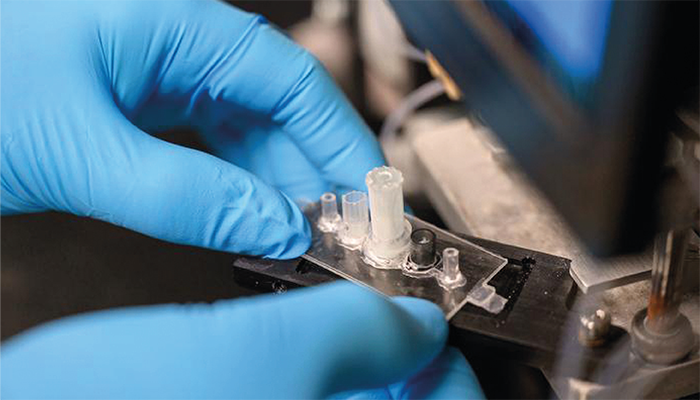
A new device can diagnose glioblastoma in under an hour using electrokinetic technology to detect active cancer biomarkers on extracellular vesicles. Developed by researchers at the University of Notre Dame, USA, the platform uses a biochip with an anion exchange membrane and silica nanoparticle reporters to measure active epidermal growth factor receptors (EGFRs). The biomarkers are overexpressed in glioblastoma and other cancers, and they can be found on extracellular vesicles secreted by cancer cells.
The biochip requires just 100 microliters of blood, costs under $2 in materials, and produces results in less than an hour.
Testing showed the device could detect as few as 30 extracellular vesicles per microliter. Blood samples from glioblastoma patients and healthy individuals were analyzed, revealing a clear distinction in active EGFR vesicle levels.
The device’s charge-sensing approach detects voltage shifts when highly charged silica nanoparticles bind to extracellular vesicles on the membrane, allowing it to accurately quantify active EGFRs.
We caught up with Hsueh-Chia Chang, the Bayer Professor of Chemical and Biomolecular Engineering at Notre Dame – and lead author of the study, to find out more.

Why did you decide to target EGFRs expressed in extracellular vesicles?
Active EGFR is known to be a generic biomarker for many cancers, such as glioblastoma (GBM), colorectal cancer (CRC), and small-cell lung cancer. The activated EGFR is responsible for the proliferation of these cancer cells. There are also cancer drugs that target these active EGFR. A diagnostic platform that can monitor the level of active EGFR in blood can potentially screen for cancers that overexpress EGFR or monitor the efficacy of drugs. However, due to their specific trans-membrane conformation, active EGFR can only sustain its activity if they are on the lipid cell membranes. There is also an abundance of unactivated EGFR in the blood from non-tumor cells. Consequently, detection and quantification of active EGFR (from tumor cells) in blood is very challenging. We realized that, since extracellular vesicles inherit the membrane of the parent cells that secrete them, the active EGFR of the tumor cells are probably also transferred to the extracellular vesicles and would remain active. Therefore, we decided to detect extracellular vesicles enriched with active EGFR instead.
What inspired your electrokinetic sensing approach?
It is difficult to assay active EGFR on extracellular vesicles with conventional ELISA assays based on electrochemical and enzymatic reporter signals. Due to the fact that they are active enzymes, active EGFR can interfere with the reporting redox reaction and their electrochemical signal can be camouflaged by the abundant redox interfering agents in the blood. We hence decided against any signal transduction technique based on electron transfer and instead chose charge sensing. The most abundant nanoparticles (extracellular vesicles, lipoproteins, and so on) and molecules in the blood have low zeta potential (< 25 mV) and hence there is very little background in the charge signal. There is also the question of sensitivity: the concentration of active EGFR-positive extracellular vesicles is at the level of fM – much lower than the detection limit of ELISA sensors. Our charge-based electrokinetic sensor can deplete the ions near the sensor that screen the charge, thus reproducibly amplifying the charge signals from our silica nanoparticle reporters. Our membrane sensor also has a high antibody density, which can result in high-affinity and high-selectivity multi-valent pull down because there are multiple copies of active EGFR on the extracellular vesicles.
Therefore, there were a multitude of reasons, but we managed to integrate them together intelligently to make the platform work.
What was the biggest challenge you had to overcome during the research? Any eureka moments?
The biggest challenge was to overcome the long incubation time for the pull down of the extracellular vesicles. With a diffusivity that is 100x to 1000x lower than most molecules, our pull down time required days initially – which right away rules it out as a commercializable diagnostic test. The eureka moment was when we realized that the multivalent capture increases the binding rate so much that the pull down is diffusion controlled. Diffusion controlled pull down is unique in that it will only deplete the analytes within a hemisphere above the sensor with the same radius as the sensor. Thus, we decreased the sensor radius from the usual cm in ELISA assays to hundreds of microns to reduce the assay time roughly 400 fold – from days to 20 minutes.
Can you explain the scalability and potential for adapting this technology to detect other types of cancer or diseases beyond glioblastoma?
The main drawback with the current design is that we need a micropump to drive a high-speed flow to remove non-specifically bound silica-nanoparticles – a controlled wash. We are working on an electric field-based washing technology. If successful, the entire device would be a thumb-drive like chip – an electrochemical lateral flow assay that can be plugged into a laptop.
To extend to other cancers or diseases, we will need to detect multiple biomarkers on the extracellular vesicles. This translates into scaling up to multiple sensors on our chip. We are currently working on this multiplex technology and will also develop its manufacturing strategy for large-volume production. Once we are done, it should be a pan-disease platform for all diseases whose biomarkers are enriched on extracellular vesicles. The list of diseases includes almost all cancers, cardiovascular disease (see our related paper using this platform), neurodegenerative disease, and so on. Current disease screening technologies have not been commercialized because they are not sufficiently sensitive and selective to work directly with untreated blood and hence cannot be converted into a consumer product. We hope our platform will be the first pan-disease extracellular vesicle diagnostic platform that realizes this vision to fundamentally transform healthcare.
What are the next steps in bringing this device from the lab to clinical settings?
The next step is to find a business partner to conduct large-scale clinical tests for regulatory approval and to implement our manufacturing strategy at an industrial scale.
Credit: Photo by Matt Cashore/University of Notre Dame



